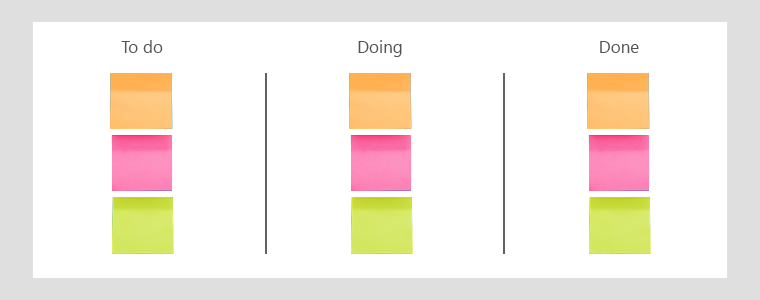5 Kanban practices to be an expert in Project Management
Updated on Mar 30, 2023 by

The Kanban methodology (Japanese word for record, board or board) was designed precisely to create an agile flow of development of project activities. Enabling continuous deliveries, Kanban is structured into stages that allow you to visualize, step by step, the progress of activities.
Thus, it is possible for a project to be divided into smaller parts, which are developed in an incremental flow until the product is finalized.
In its original conception, Kanban is structured into three main phases that represent the status of each task: To do (to do), Doing (doing/being done) and Done (done).
By separating these three phases visually (on a board, spreadsheet or even in software) you will have activities circulating between them. It looks more or less like the following image:

Having the Kanban methodology applied to good Project Management software, at the end of the development of each activity you will be able to infer data such as execution time, required budget, bottlenecks in the process and a series of other information relevant to the agile management of development teams .
But, it’s just not as simple as it seems. Applying Kanban in agile Project Management requires attention to some points that may be the key to success.
Therefore, thinking about helping you get the most out of this methodology, we have listed 5 good practices about Kanban so that you can be an expert in managing your projects. Check it out below:
1. Create a coherent workflow
As we have already mentioned, Kanban is originally divided into three parts that indicate the stages of development of each activity within the project – To do, Doing and Done.
However, this does not mean that you should follow the rules and segment your task statuses into just these three stages.
For Kanban to be successful in your management strategy, you need to structure a workflow that is in accordance with the reality of your development process.
Therefore, understanding how Kanban can fit into your processes and adapt it to your company’s workflow is the first step towards making the application of this methodology a facilitator, and not just another bureaucratic obstacle.
2. Prioritize Kanban
We know that the development queue can be an inexhaustible source of tasks to be done, and that it is not always easy to establish priorities as everything seems to be equally urgent.
However, knowing how to determine what is most important among the tasks that need to be carried out is very important so that you do not run into obstacles in the development of a project.
Furthermore, establishing an order of importance for what needs to be done also helps the team to have more focus in completing tasks, avoiding the known interruptions to “put out fires” from other priority activities that were left behind at the time of planning.
3. Limit the amount of activities in progress
With a large number of items to do, it is common for the team to become anxious to complete tasks. However, a large number of activities going on at the same time can be nothing more than a bottleneck in your development process.
Limiting the number of items that can be simultaneously under development is an essential practice so that the purpose of Kanban is not lost, as the idea is to maintain an increasing flow of delivering value to the customer, and not just a pile of pending tasks that transition from one stage to another.
Encourage each team member to prioritize a single activity at a time to complete it completely and then make it available for the next step.
This way, you maintain a productive flow without overloads for all stages.
4. Organize categories within each step
If you are a developer or a project manager, you know that there is no single type of task involved in a software development project.
Therefore, creating subcategories within the stages of activities (to be done, being done and completed) is very important so that you can always see which subcategory has been occupying your team the most.
For example, within development it is possible to categorize activities into bugs, new features, updates and a series of others. This way, it becomes visibly easier to identify which area has required the most effort from your team to act on.
5. Periodically analyze obstacles
Analyzing obstacles and difficulties faced during the execution of a project may seem obvious, but many people still ignore the importance of periodically diagnosing obstacles in their process.
Therefore, our last indication of good practices draws attention precisely to this point: the analysis of obstacles.
As we have already said, adopting the Kanban methodology makes it visibly clear which steps most hinder your team’s workflow.
However, just visualizing does not solve the problem. It is necessary to investigate the reasons why a large number of activities are blocked and then act on them.
Now that you know the main best practices for applying Kanban in agile project management, we have great news. All this knowledge you can put into practice using Gipo.
Analyzing the structure of this functionality in Gipo, many of the tips we gave in the items above become clear.
Furthermore, in Gipo, in each activity it is possible to measure the number of hours spent using the time tracker feature, which totals the notes for each activity, and also the general sum of hours spent on the project.
For the manager, this functionality is a major advance in managing team activities, as it makes it much easier and faster to monitor the status of everything that is being produced by your team in real time.
By applying these 5 tips and counting on the help of good software, you will certainly be on the path to expertise in Project Management.
